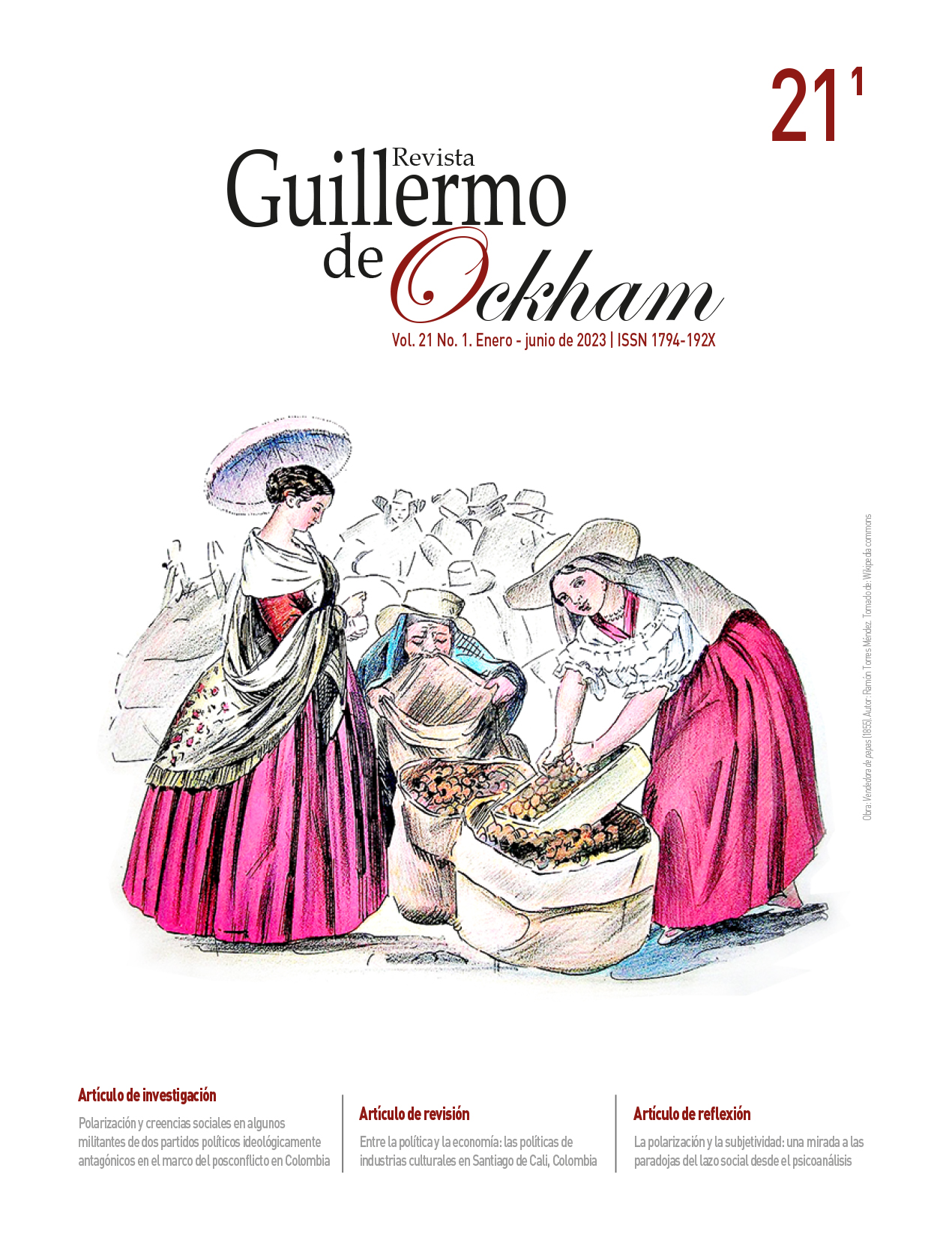La Revista Guillermo de Ockham brinda un acceso inmediato y abierto a su contenido, basado en el principio de ofrecer al público un acceso gratuito a las investigaciones para brindar un intercambio global de conocimiento. A menos que se establezca lo contrario, el contenido de esta revista tiene una licencia con Creative Commons Attribution-NonCommercial-NoDerivatives 4.0 International (CC BY-NC-ND 4.0) http://creativecommons.org/licenses/by-nc-nd/4.0/
- Atribución: debe otorgar el crédito correspondiente, proporcionar un enlace a la licencia e indicar si se realizaron cambios. Puede hacerlo de cualquier manera razonable, pero no de ninguna manera que sugiera que el licenciante lo respalda a usted o su uso.
- No comercial: no puede utilizar el material con fines comerciales.
- Sin derivados: si remezcla, transforma o construye sobre el material, no puede distribuir el material modificado.
- Sin restricciones adicionales: no puede aplicar términos legales o medidas tecnológicas que restrinjan legalmente a otros de hacer cualquier cosa que permita la licencia.
Resumen
El objetivo de la investigación es examinar y evaluar la literatura existente sobre el eWOM (electronic Word Of Mouth o voz a voz electrónico) por medio de un análisis bibliométrico, que incluye importantes herramientas de mapeo científico. Para esto, se llevó a cabo una búsqueda bibliográfica en la base de datos Scopus, la cual arrojó 841 publicaciones que fueron estudiadas mediante tres tipos de indicadores: cantidad, calidad y estructurales. Asimismo, para lograr una mejor visualización de los datos, se utilizó el programa VOSviewer, que permitió generar redes bibliométricas de acoplamiento bibliográfico y de coocurrencia de términos, con los cuales se identificaron las principales áreas de investigación. De este modo, se logró evidenciar que los estudios en eWOM han tenido un crecimiento progresivo en los últimos cinco años; su producción es liderada por países desarrollados como Estados Unidos, Taiwán y España, con poca representatividad de las naciones latinoamericanas. A partir de un análisis cualitativo de la literatura más reciente, se definieron las futuras líneas de investigación para el desarrollo de estudios complementarios.
Palabras clave:
Referencias
Araújo, C. A. A. (2006). Bibliometria: evolução histórica e questões atuais. Em Questão, 12(1), 11-32. https://seer.ufrgs.br/index.php/EmQuestao/article/view/16
Ardanuy, J. (2012, abril). Breve introducción a la bibliometría. Universitat de Barcelona. https://bit.ly/3wH7eym
Babić, A., De Valck, K., y Sotgiu, F. (2020). Conceptualizing the electronic Word-of-mouth process: What we know and need to know about eWOM creation, exposure, and evaluation. Journal of the Academy of Marketing Science, 48(3), 422-448. https://doi.org/10.1007/s11747-019-00706-1
Bansal, H. S., y Voyer, P. A. (2000). Word-of-mouth processes within a services purchase decision context. Journal of Service Research, 3(2), 166-177. https://doi.org/10.1177/109467050032005
Cadavid, L., Awad, G., y Franco, C. J. (2012). Análisis bibliométrico del campo modelado de difusión de innovaciones. Estudios Gerenciales, 28(EE), 213-236. https://doi.org/10.18046/j.estger.2012.1486
Cañedo, R., Rodríguez, R., y Montejo, M. (2010). Scopus: la mayor base de datos de literatura científica arbitrada al alcance de los países subdesarrollados. Revista Cubana de ACIMED, 21(3), 270-282. http://www.redalyc.org/articulo.oa?id=377657496004
Chan, Y. Y. Y., y Ngai, E. W. T. (2011). Conceptualising electronic word of mouth activity: An input-process-output perspective. Marketing Intelligence and Planning, 29(5), 488-516. https://doi.org/10.1108/02634501111153692
Cheung, C. M. K., Lee, M. O. K., y Rabjohn, N. (2008). The impact of electronic word-of-mouth: The adoption of online opinions in online customer communities. Internet Research, 18(3), 229-247. https://doi.org/10.1108/10662240810883290
Cheung, M. Y., Luo, C., Sia, C. L., y Chen, H. (2009). Credibility of electronic word-of-mouth: Informational and normative determinants of on-line consumer recommendations. International Journal of Electronic Commerce, 13(4), 9-38. https://doi.org/10.2753/jec1086-4415130402
Chu, S. C., Chen, H. T., y Gan, C. (2020). Consumers’ engagement with Corporate Social Responsibility (CSR) communication in social media: Evidence from China and the United States. Journal of Business Research, 110, 260-271. https://doi.org/10.1016/j.jbusres.2020.01.036
Chu, S. C., y Kim, Y. (2011). Determinants of consumer engagement in electronic Word-Of-Mouth (eWOM) in social networking sites. International Journal of Advertising, 30(1), 47-75. https://doi.org/10.2501/IJA-30-1-047-075
Dellarocas, C. (2003). The digitization of word of mouth: Promise and challenges of online feedback mechanisms. Management Science, 49(10), 1407-1424. https://www.jstor.org/stable/4134013
Dwyer, P. (2007). Measuring the value of electronic word of mouth and its impact in consumer communities. Journal of Interactive Marketing, 21(2), 63-79. https://doi.org/10.1002/dir.20078
Goldsmith, R. E., y Horowitz, D. (2006). Measuring motivations for online opinion seeking. Journal of Interactive Advertising, 6(2), 2-14. https://doi.org/10.1080/15252019.2006.10722114
Gruen, T. W., Osmonbekov, T., y Czaplewski, A. J. (2006). eWOM: The impact of customer-to-customer online know-how exchange on customer value and loyalty. Journal of Business Research, 59(4), 449-456. http://dx.doi.org/10.1016/j.jbusres.2005.10.004
Hall, C. M. (2011). Publish and perish? Bibliometric analysis, journal ranking and the assessment of research quality in tourism. Tourism Management, 32(1), 16-27. https://doi.org/10.1016/j.tourman.2010.07.001
Harrison-Walker, L. J. (2001). E-complaining: a content analysis of an Internet complaint form. Journal of Services Marketing, 15(5), 397-412. https://doi.org/10.1108/EUM0000000005657
Hawkins, D. I., Best, R. J., y Coney, K. A. (2004). Consumer behavior: Building marketing strategy (9.a ed.). McGraw-Hill.
Hennig-Thurau, T., Gwinner, K. P., Walsh, G., y Gremler, D. D. (2004). Electronic word-of-mouth via consumer-opinion platforms: What motivates consumers to articulate themselves on the Internet? Journal of Interactive Marketing, 18(1), 38-52. https://doi.org/10.1002/dir.10073
Hennig-Thurau, T., Malthouse, E. C., Friege, C., Gensler, S., Lobschat, L., Rangaswamy, A., y Skiera, B. (2010). The impact of new media on customer relationships. Journal of Service Research, 13(3), 311-330. https://doi.org/10.1177/1094670510375460
Hennig-Thurau, T., y Walsh, G. (2003). Electronic word-of-mouth: Motives for and consequences of reading customer articulations on the Internet. International Journal of Electronic Commerce, 8(2), 51-74. https://doi.org/10.1080/10864415.2003.11044293
Hung, K. H., y Li, S. Y. (2007). The influence of eWOM on virtual consumer communities: Social capital, consumer learning, and behavioral outcomes. Journal of Advertising Research, 47(4), 485-495. https://doi.org/10.2501/s002184990707050x
Jansen, B. J., Zhang, M., Sobel, K., y Chowdury, A. (2009). Twitter power: Tweets as electronic word of mouth. Journal of the American Society for Information Science and Technology, 60(11), 2169-2188. https://doi.org/10.1002/asi.21149
Lee, E. J., y Shin, S. Y. (2014). When do consumers buy online product reviews? Effects of review quality, product type, and reviewer’s photo. Computers in Human Behavior, 31, 356-366. https://doi.org/10.1016/j.chb.2013.10.050
Lenhart, A., Purcell, K., Smith, A., y Zickuhr, K. (2010, 3 de febrero). Social media & mobile Internet use among teens and young adults. PEW Research Center. https://bit.ly/3NtoON3
León, A. M., Castellanos, Ó. F., y Vargas, F. A. (2006). Valoración, selección y pertinencia de herramientas de software utilizadas en vigilancia tecnológica. Ingeniería e Investigación, 26(1), 92-102. https://doi.org/10.15446/ing.investig.v26n1.14680
Litvin, S. W., Goldsmith, R. E., y Pan, B. (2008). Electronic word-of-mouth in hospitality and tourism management. Tourism Management, 29(3), 458-468. https://doi.org/10.1016/j.tourman.2007.05.011
Liu, S. Q., Ozanne, M., y Mattila, A. S. (2018). Does expressing subjectivity in online reviews enhance persuasion? Journal of Consumer Marketing, 35(4), 403-413. https://doi.org/10.1108/jcm-02-2017-2109
Liu, Y. (2006). Word of mouth for movies: Its dynamics and impact on box office revenue. Journal of Marketing, 70(3), 74-89. https://doi.org/10.1509/jmkg.70.3.074
López, J. M. (1972). El análisis estadístico y sociométrico de la literatura científica. Centro de Documentación Informática Médica.
McWilliam, G. (2000). Building stronger brands through online communities. Sloan Management Review, 41(3), 43-54. https://bit.ly/3PD5azS
Nam, K., Baker, J., Ahmad, N., y Goo, J. (2020). Dissatisfaction, disconfirmation, and distrust: An empirical examination of value co-destruction through negative electronic Word-Of-Mouth (eWOM). Information Systems Frontiers, 22(1), 113-130. https://doi.org/10.1007/s10796-018-9849-4
Oliver, R. L. (1999). Whence customer loyalty? Journal of Marketing, 63, 33-44. https://doi.org/10.2307/1252099
Park, D. H., y Kim, S. (2008). The effects of consumer knowledge on message processing of electronic word-of-mouth via online consumer reviews. Electronic Commerce Research and Applications, 7(4), 399-410. https://doi.org/10.1016/j.elerap.2007.12.001
Park, D. H., Lee, J., y Han, I. (2007). The effect of on-line consumer reviews on consumer purchasing intention: The moderating role of involvement. International Journal of Electronic Commerce, 11(4), 125-148. https://doi.org/10.2753/JEC1086-4415110405
Phelps, J. E., Lewis, R., Mobilio, L., Perry, D., y Raman, N. (2004). Viral marketing or electronic word-of-mouth advertising: Examining consumer responses and motivations to pass along email. Journal of Advertising Research, 44(4), 333-348. https://doi.org/10.1017/s0021849904040371
Reyes-Menéndez, A., Correia, M. B., Matos, N., y Adap, C. (2020). Understanding online consumer behavior and eWOM strategies for sustainable business management in the tourism industry. Sustainability, 12(21), 8972. https://doi.org/10.3390/su12218972
Richins, M. L., y Root-Shaffer, T. (1988). The role of involvement and opinion leadership in consumer word-of-mouth: An implicit model made explicit. Advances in Consumer Research, 15, 32-36. https://bit.ly/38I0EQ7
Rodríguez, A., Osorio, C. F., y Peláez, J. (2020). Dos décadas de investigación en electronic word-of-mouth: un análisis bibliométrico. Revista Científica Pensamiento y Gestión, (48), 250-275. https://bit.ly/3Nt5uPV
Rueda, G., Gerdsri, P., y Kocaoglu, D. F. (2007). Bibliometrics and social network analysis of the nanotechnology field. PICMET, (2007), 2905-2911. http://dx.doi.org/10.1109/PICMET.2007.4349633
Sen, S., y Lerman, D. (2007). Why are you telling me this? An examination into negative consumer reviews on the Web. Journal of Interactive Marketing, 21(4), 76-94. https://doi.org/10.1002/dir.20090
Solano, E., Castellanos, S. J., López, M. M., y Hernández, J. I. (2009). La bibliometría: una herramienta eficaz para evaluar la actividad científica postgraduada. Revista Electrónica de las Ciencias Médicas en Cienfuegos, 7(4), 291-294. http://www.medisur.sld.cu/index.php/medisur/article/view/745
Sparks, B. A., y Browning, V. (2011). The impact of online reviews on hotel booking intentions and perception of trust. Tourism Management, 32(6), 1310-1323. https://doi.org/10.1016/j.tourman.2010.12.011
Spinak, E. (1996). Diccionario enciclopédico de bibliometría, cienciometría e informetría. Unesco. https://bit.ly/3sPWQTX
Thorson, K. S., y Rodgers, S. (2006). Relationships between blogs as eWOM and interactivity, perceived interactivity, and parasocial interaction. Journal of Interactive Advertising, 6(2), 5-44. https://doi.org/10.1080/15252019.2006.10722117
Van Eck, N. J., y Waltman, L. (2010). Software survey: VOSviewer, a computer program for bibliometric mapping. Scientometrics, 84(2), 523-538. https://doi.org/10.1007/s11192-009-0146-3
Van Eck, N. J., y Waltman, L. (2019, 10 de enero). Manual for VOSviwer version 1.6.10. CWTS Meaningful Metrics. https://bit.ly/3MGbAfN
Van Eck, N. J., Waltman, L., Dekker, R., y Van Den Berg, J. (2010). A comparison of two techniques for bibliometric mapping: Multidimensional scaling and VOS. Journal of the American Society for Information Science and Technology, 64(12), 2405-2416. https://doi.org/10.1002/asi.21421
Vermeulen, I. E., y Seegers, D. (2009). Tried and tested: The impact of online hotel reviews on consumer consideration. Tourism Management, 30(1), 123-127. https://doi.org/10.1016/j.tourman.2008.04.008
Wallin, J. A. (2005). Bibliometric methods: Pitfalls and possibilities. Basic and Clinical Pharmacology and Toxicology, 97(5), 261-275. https://doi.org/10.1111/j.1742-7843.2005.pto_139.x
Westbrook, R. A. (1987). Product/consumption-based affective responses and postpurchase processes. Journal of Marketing Research, 24(3), 258-270. https://doi.org/10.1177/002224378702400302

 Perfil Google Scholar
Perfil Google Scholar































